
In Search of Silog’s Origin Story.
Silog is a must-have dish when in the Philippines. It is the quintessential breakfast of the nation. Find out what silog means and the history of the parts of the dish that makes up a plate of silog:
Silog History – What Silog Means & How It Eventually Came To Be
“Silog” combines two Filipino foods “sinangag” (garlic fried rice) and “itlog” (egg).
Essentially, silog is a breakfast dish using up last night’s leftover white rice that’s cooked into garlic rice, with a fried egg, a protein of your choice, and a side of sweet pickled papaya called atsara.
The most common silogs are tapsilog, tocilog, longsilog, and bangsilog. The names of each silog come from using the first syllable fo the protein and adding that to the front of the world silog. You can literally silog anything – corned beef silog becomes cornsilog, fried chicken silog becomes chicksilog, and so on.
Find out more about the details of silog variations and tasting tips for the best eating experience:
Silogs for Breakfast, aka Filipino Comfort Food.
Tapsilog – Perhaps the First Silog
The first silog is thought to be the tapsilog, using the local dried or cured beef tapa, created in the 1980s. What is tapa? Well, the history of this component to silog has a few interesting origin theories:
Tapa Theory #1:
It has been said that tapa goes back before the Spanish colonization. In Sanskrit, tapas means “heat” which was applied to preserving meat that was dried under the heat of the sun.
Tapa Theory #2:
Tapa may have influence from Chinese traders who introduced soy sauce to the country. Locals learned how to marinate the meat before drying it out. Aside from the meat, these traders also passed on the idea of fried rice which was simply interpreting by cooking the rice in oil, garlic, and salt.
Tapa Theory #3:
A third theory suggests that tapa roots back to the Spaniards in the country centuries ago. “Tapa” comes from the verb “tapar” meaning to cover or seal. This is the same root word for what we know as tapas in Spain
In the days of Spanish colonial Philippines, Spaniard would eat chunks of meat with liquor.
Across the world in Andalusia, in southern Spain, taverns would cover their glasses of local sherry with their little plate of bread slices or meat chunks (typically ham or chorizo) in order to prevent fruit flies from hovering over their sweet sherry. The act of cover the drink is called “tapar”.
Bartenders and restaurant owners in Andalusia caught on and began to make a variety of snacks to serve with sherry as a way to increase their alcohol sales. This soon became known as “tapas”.
Back in the Philippines, these Spaniards would salt cure the local meat available to pair with their liquor. Locals interpreted the meat with thinly cut beef (or any local meat really, like mutton, carabao, or goat), that they dried or salt-cured it and pan-fried. From the Spanish “tapas”, came the Filipino “tapa”.
Then, some decades later in the 1980s, tapa was added to a plate of garlic fried rice and a fried egg and the silog craze spread across the country.
Today, you can find silogs all over the country, from cheap canteens to fancy modern Filipino tasting menus. For most travelers, they can experience a taste in the country’s hotels and resorts for breakfast. Silog is truly a staple dish that comforts, warms, and delights.
Read more about Silog:
Silogs for Breakfast, aka Filipino Comfort Food
Simple Silog Recipe – Garlic Rice & the Fried Egg
Sign up for my newsletter on the sidebar for blog updates and my travel insider tips! And, check out my vlogs on YouTube!


